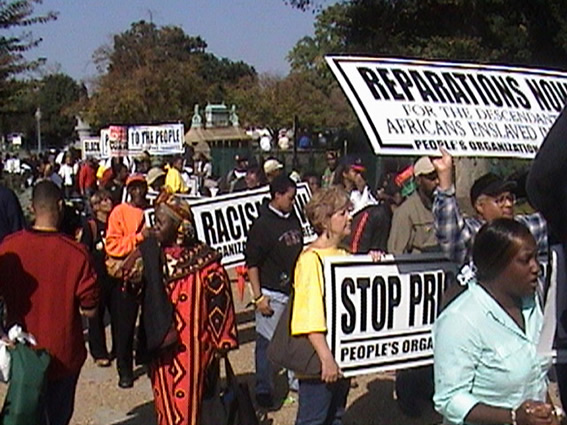
Military Out of Our Schools Now
• National “Not Your Soldier” Youth and Student Day of Action
• Military Recruiting Crisis Deepens: Youth Saying No To War
Failed U.S. State
• Militarization of Public Health and Disaster Relief
• Martial Law and the Avian Flu Pandemic
• Bush’s Risky Flu Pandemic Plan• For Your Information: Bush Statements Calling for Increased Role of Military
Photos
• Millions More March, Washington, D.C., October 15, 2005
National “Not Your Soldier” Youth and Student Day of Action
Get Involved!
Organize one of the many events listed below or do something completely different! The important thing is to let this day of action bring forward the voices, demands and ideas of our generation; it’s time to speak for ourselves. This means we need to hear from youth and students in your area!
• Hold a Demo/Rally at a School or Community Recruiting Station to declare a “Not Your Soldier” zone
• Offer Solutions! Organize an “alternative” recruitment fair – invite college recruiters, local unions, job recruiters, activist organizations and others to table and show the alternatives to the military
• Demand a Meeting with your school administration to discuss your specific demands (if they don’t agree, organize a petition drive or demonstration to make sure they do!)
• Get creative! Organize a concert, open mic or party with music, poetry, theater and art against military recruitment!
• Host a Forum or Debate on Military Recruitment! Invite community activists, teachers and parents to come listen to young people talk about their experiences, ideas and opinions on military recruitment, the poverty draft and the war!
• Be Visible! Set up a table, do sidewalk chalking, create a public graffiti wall, do a banner drop - let people know what young people really think about the war, military recruitment and the kind of future we want for our generation!
Don’t Forget: Invite school administrators, teachers/professors, community leaders, city officials, etc. to whatever activity you plan!
Connect!
The National Youth and Student Peace Coalition wants to amplify your voice and your demands. Tell us your story, announce your event, and we’ll help get the word out to the media and other youth and students. We’ve found the website www.campusactivism.org to be a great tool for activists. Check it out! Coming up at www.campusactivism.org, under the category Books Not Bombs, you will be able to:
* Register your Not Your Soldier event
* Learn about/connect with other Not Your Soldier events around the country and in your area
* Download upcoming resources, images for posters, sample press release, and more.
* Share the resources you’ve created Counter Recruitment websites you need to see!
American Friends Service Committee
Counter Recruiter.net (a news site)
Fellowship of Reconciliation “I Will Not Kill” Campaign
National Network Opposing Militarization of Youth
Not Your Soldier Training Camps
Nuclear Age Peace Foundation’s Demilitarization Guide
Student Peace Action Network
United for Peace and Justice Counter-Recruitment Working Group
War Resisters League
National Youth and Student Peace Coalition sponsored the Books Not Bombs national student strike of March 5, 2003 and the Books Not Bombs Youth Convergence Center held during the Republican National Convention. NYSPC is organizing around the country to take back our future and build the Books Not Bombs agenda for youth and students. To learn more visit www.nyspc.net.
[TOP]
Military Recruiting Crisis Deepens
Youth Saying No To War
Reflecting the growing and determined opposition to imperialist war against Iraq, more and more youth are refusing intense efforts by the armed forces to recruit more youth. As a result, the U.S. Army fell 8 percent (7,000 recruits) short of its recruitment goal. It has not fallen so short of its annual goal since 1979, several years after the Vietnam War. The part-time Army Reserve and Army National Guard did even worse.
The Army also has a smaller-than-usual reservoir of enlistees as it begins the new recruiting year. This pool comes from what the Army calls its delayed-entry program in which recruits -commit to join the Army on condition that they ship to boot camp some months later. General Peter Schoomaker, the Army chief of staff, has said the pool is the smallest in history.
Army Secretary Francis Harvey told reporters that he was concerned about recruitment levels in the last 12 months. He admitted that broad opposition to the war on Iraq is the main reason for the decline in enlistments. Richard Cody, the Army’s deputy chief of staff, said at a separate news briefing that with the shortfall, the Army would not be able to increase in size to 502,000 as planned, and would remain at around 492,000 to 493,000. The Army provides the bulk of ground troops in the more-than-140,000-strong U.S. forces currently deployed in Iraq.
An enormous increase in the number of Army recruiters (from 9,000 to 12,000), the Army’s advertising budget (by $130 million), enlistment bonuses (from a maximum of $20,000 to a new limit of $40,000), and various other enticements have not succeeded in getting more recruits. Several involuntary extensions of thousands of soldiers, so-called “stop-loss” orders, have also not solved the problem. Recruiters are under such intense pressure to increase enlistments that they are engaging in desperate and deceptive tactics.
The Army has also lowered standards for enlistment, lowered enlistment quotas, and tried shorter enlistment options. For example, the Army is now using looser Pentagon rules that permit it to sign up more high school dropouts and people who score lower on qualification tests. In addition, the Pentagon recently established a massive, new, privately operated database (JAMRS, Joint Advertising and Marketing Research & Studies Office) that spies on students and youth, collecting large quantities of information on each individual, mainly for recruiting purposes. None of the measures have overcome the increased opposition, among the youth, military families and existing soldiers.
The growing pressure by the military on high school administrators is also increasing. In Hutchinson-Central Technical (Hutch-Tech) High School in Buffalo, New York, freshmen (14-year-olds) were being automatically enrolled in the school’s Junior ROTC program, without parental consent. When parents discovered what was happening they strongly objected and protested, greatly reducing the number enrolled in the program.
The youth and parents, backed by the New York Civil Liberties Union (NYCLU) are demanding that the practice be stopped. “The school has engaged in a blatant violation of students’ and parents’ rights under the state education law by auto-enrolling freshmen in Junior ROTC,” said Donna Lieberman, the NYCLU’s executive director. “Under the law the school has no authority to enroll a student in Junior ROTC without prior written parental consent.”
And recently in Colorado, hundreds of Idaho National Guardsmen mobilized for hurricane relief efforts were housed in Middle Schools (e.g., Longmont Middle School and Coal Ridge Middle School) instead of one of the many military bases in Colorado. They openly talked with the youth, showed them their weapons, and encouraged them to become soldiers. Parents in the area demanded that the troops be housed in military facilities and not be used as recruiters for their young sons and daughters.
[TOP]
Militarization of Public Health and Disaster Relief
In the face of the failed U.S. state, the Bush government is moving forward with efforts for military control inside the country. In the space of just a few weeks, the White House has several times called for an increased role for the military inside the country.
In the wake of the government organized Katrina disaster in the aftermath of the hurricane, President George W. Bush said, “It is now clear that a challenge on this scale requires greater federal authority and a broader role for the armed forces—the institution of our government most capable of massive logistical operations on a moment’s notice.” (September 15, New Orleans, Louisiana)
In response to a clearly planned question and response concerning the -possibility of an bird-flu pandemic, Bush said, “If we had an outbreak somewhere in the United States, do we not then quarantine that part of the country?…And who best to be able to affect a quarantine? One option is the use of a military that’s able to plan and move…I think the president ought to have all assets on the table to be able to deal with something this significant.” (Press Conference, October 4, 2005)
In both instances, Bush is calling for the military to be in charge of public health and public disaster relief. This serves to eliminate both of these areas as public services, along with their civilian governmental agencies at all levels, and turn them instead into areas for military dictate and control. This includes potential military enforced quarantines, as Bush suggests, for any variety of reasons, including “threats” of biological weapons as well as influenza. It also includes forced vaccinations, as members of the armed forces have already been subject to, suffering major medical problems as a result. The public is no longer to be the public, but rather refugees, or individuals under quarantine, or “threats to national security.” If military quarantines can be imposed for “health” purposes, why not for isolating a “terrorist cell” in an Arab community? As seen in New Orleans, a military quarantine, like the curfews, could also be used to specifically target African Americans or Asians or other national minorities, as well as whole communities and states.
It is well-known that the main role of the military in the aftermath of Katrina was to prevent numerous civilian groups, including the Red Cross and others, from providing food and water and similar relief, while enforcing curfews and “shoot to kill” orders. As a representative of the American Friends Services Committee, one of the groups active in relief put it, “With images of soldiers in New Orleans carrying M-16s but no medical or relief supplies fresh in the public memory, the president would still have us believe that a military response is the preferred response.” It is also the case that the government has said the presence of the military in the Gulf States will continue until at least the spring. The precedent for military control has been established.
Coupled with these calls for military control is the general discrediting of local and state and even federal officials, described as “overwhelmed” with the situation, and the promotion of the military as the force “most capable” of quarantine, or disaster relief, or terrorist threats.
This was further evidenced in Bush’s call for adding $6 billion in the Department of Defense (DoD) appropriations bill, likely to be more than $440 billion, for vaccines and related research. Normally this would be a matter for the public health departments, not DoD. The Senate approved $4.9 billion for “pandemic influenza preparedness” in the Pentagon bill, which has not yet been passed.
It is interesting to note that the flu virus is an air-borne virus, which means a quarantine would have little health impact. The main impact it does have is the ability of the military to eliminate the body politic as a public body with rights in society and reduce people instead to refugees or individuals in quarantine, etc. This too was already witnessed with Katrina and remains a major battle between the government and public in terms of the rights of all those displaced to return, rebuilding of their homes, reparations and so forth.
As well, in an article reprinted by several major newspapers, the Council on Foreign Relation’s global health expert emphasized that the DoD should get at least the $3.9 billion and that it should engage the pharmaceutical industry in developing a flu vaccine for “quick mass production.” In this manner public health institutions and resources, as well as private monopolies, are being further militarized.
[TOP]
Martial Law and the Avian Flu Pandemic
The threat of the avian flu pandemic is real. Until recently, national governments and the WHO have dismissed the seriousness of the crisis. The public has been misinformed. The issue has been barely mentioned by the media. Why all of a sudden is avian flu on the presidential agenda?
The issue was placed on the agenda of the President’s White House Press Conference (October 4, 2005). There was nothing spontaneous in the White House journalist’s question to President Bush, which explicitly pointed to a role for the country’s “defense assets” in the case of a pandemic.
We are not dealing with an off-the-cuff statement. Both the question as well as Bush’s response calling for a greater role of the Military, had been prepared in advance (see Bush statement below).
Militarization of Public Health
The statement of President Bush suggests the enactment of Martial Law in the case of an avian flu outbreak. Martial Law could also be established, using the pretext of an outbreak of avian flu in foreign countries and its potential impacts on the U.S. In other words, the Military rather than the country’s civilian health authorities would be put in charge.
A decision to put the Military in charge of a public health emergency spells disaster, as evidenced by the intervention of the Military in -hurricane relief in Louisiana and Southern Texas.
The pandemic is being presented to public opinion as an issue of National Security, with a view to triggering the militarization of civilian institutions in blatant violation of the Posse Comitatus Act…
The hidden agenda consists in using the threat of a pandemic and/or the plight of a natural disaster as a pretext to establish military rule, under the facade of a “functioning democracy”.
What Bush’s statements suggest is that Congress should enact legislation which will in practice suspend Constitutional government and allow the Military to intervene in civilian affairs in violation of the Posse Comitatus Act. The latter, however, while still on the books, is in practice already defunct. (See Frank Morales at http://globalresearch.ca/articles/MOR309A.html).
Legislation inherited from the Clinton administration, not to mention the post 9/11 Patriot Acts I and II, “blurs the line between military and civilian roles”. It allows the military to intervene in judicial and law enforcement activities even in the absence of an emergency situation.
In 1996, legislation was passed which allowed the military to intervene in the case of a national emergency (e.g. a terrorist attack). In 1999, Clinton’s Defense Authorization Act (DAA) extended those powers (under the 1996 legislation) by creating an “exception” to the Posse Comitatus Act, which permits the military to be involved in civilian affairs “regardless of whether there is an emergency”. (See ACLU at http://www.aclu.org/NationalSecurity/NationalSecurity.cfm?ID=8683&c=24)
Despite this 1999 “exception” to the Posse Comitatus Act,” which -effectively invalidates it, both the Pentagon and Homeland Security, have been actively lobbying Congress for the outright repeal of the 1878 legislation.
To achieve public support for the Military to become “the lead agency”, the Bush administration is not only resorting to the usual counter-terrorism justification. Other supportive criteria are being developed to justify military rule. In this regard, at the height of Hurricane Katrina, meetings were held under the auspices of U.S. Northern Command, involving the participation of Bush, Rumsfeld and Chertoff, to examine the role of the military in disaster relief.
According to the Wall Street Journal (Oct 1, 2005), the Bush administration plans to ask Congress for an estimated $6-10 billion “to stockpile vaccines and antiviral medications as part of its plans to prepare the U.S. for a possible flu pandemic.” […] What we are dealing with is a process of militarization of the civilian budget. Civilian social sector budgets are now being transferred to the Department of Defense. The money for a public health program is controlled by the Department of Defense, under the rules of DoD procurement…
Multibillion Financial Bonanza for the BioTech Conglomerates
The threat of the avian flu pandemic will result in multibillion-dollar earnings for the pharmaceutical and biotech industry.
In this regard, a number of major pharmaceutical companies including GlaxoSmithKline, Sanofi-Aventis, California-based Chiron Corp, BioCryst Pharmaceuticals, Inc, Novavax and Wave Biotech, and Swiss pharmaceutical giant Roche Holding, have positioned themselves in the procurement of vaccines in case of an avian flu outbreak. Maryland-based biotechnology company MedImmune that produces “an inhaled flu vaccine” has also positioned itself to develop a vaccine against the H5N1 avian flu.
(Although it has no expertise in the avian flu virus, one of the major actors in the vaccine business, on contract to the Pentagon, is Bioport, a company which is part owned by the Carlyle Group, which is closely linked to the Bush Cabinet with Bush Senior on its board of directors.)
Michel Chossudovsky is Professor of Economics at the University of Ottawa and Director of the Center for Research on Globalization (CRG).
[TOP]
Bush Statements Calling for Increased Role of Military
In the aftermath of Hurricane Katrina:
“Our cities must have clear and up-to-date plans for responding to natural disasters, and disease outbreaks, or a terrorist attack, for evacuating large numbers of people in an emergency, and for providing the food and water and security they would need. In a time of terror threats and weapons of mass destruction, the danger to our citizens reaches much wider than a fault line or a flood plain. I consider detailed emergency planning to be a national security priority, and therefore, I’ve ordered the Department of Homeland Security to undertake an immediate review, in cooperation with local counterparts, of emergency plans in every major city in America.
“I also want to know all the facts about the government response to Hurricane Katrina. The storm involved a massive flood, a major supply and security operation, and an evacuation order affecting more than a million people. It was not a normal hurricane—and the normal disaster relief system was not equal to it. Many of the men and women of the Coast Guard, the Federal Emergency management Agency, the United States military, the National Guard, Homeland Security, and state and local government performed skillfully under the worst conditions. Yet the system, at every level of government was not well-coordinated, and was overwhelmed in the first few days. It is now clear that a challenge on this scale requires greater federal authority and a broader role for the armed forces — the institution of our government most capable of massive logistical operations on a moment’s notice.” — September 15 speech, New Orleans, Louisiana
In the aftermath of Hurricane Rita:
“...The other question, of course, I asked, was, is there a circumstance in which the Department of Defense becomes the lead agency. Clearly, in the case of a terrorist attack, that would be the case, but is there a natural disaster which — of a certain size that would then enable the Defense Department to become the lead agency in coordinating and leading the response effort. That’s going to be a very important consideration for Congress to think about.” — Press Conference, September 25, 2005
Speaking on a Possible Avian Flu Pandemic:
QUESTION: “Mr. President, you’ve been thinking a lot about pandemic flu and the risks in the United States if that should occur.
“I was wondering, Secretary Leavitt has said that first responders in the states and local governments are not prepared for something like that. To what extent are you concerned about that after Katrina and Rita?
“And is that one of the reasons you’re interested in the idea of using defense assets to respond to something as broad and long-lasting as a flu might be?
BUSH: “Yes. Thank you for the question. I am concerned about avian flu. I’m concerned about what an avian flu outbreak could mean for the United States and the world…
“The policy decisions for a president in dealing with an avian flu outbreak are difficult. One example: If we had an outbreak somewhere in the United States, do we not then quarantine that part of the country? And how do you, then, enforce a quarantine? It’s one thing to shut down airplanes. It’s another thing to prevent people from coming in to get exposed to the avian flu.
BUSH: “And who best to be able to affect a quarantine?
“One option is the use of a military that’s able to plan and move. So that’s why I put it on the table. I think it’s an important debate for Congress to have.
“I noticed the other day, evidently, some governors didn’t like it. [38 Governors opposed the suggestion-BF] I understand that…But Congress needs to take a look at circumstances that may need to vest the capacity of the president to move beyond that debate. And one such catastrophe or one such challenge could be an avian flu outbreak. […]
“Obviously, it would be helpful if we had a breakthrough in the capacity to develop a vaccine that would enable us to feel comfortable here at home, that not only would first responders be able to be vaccinated, but as many Americans as possible, and people around the world.
“But, unfortunately, we’re just not that far down the manufacturing process…So one of the issues is how do we encourage the manufacturing capacity of the country, and maybe the world, to be prepared to deal with the outbreak of a pandemic? [Bush called for adding $6 billion to the Defense Department budget for vaccines and related research; the Senate authorized $3.9 billion. The final bill has not yet been passed. — editor]
“[…] I’m not predicting an outbreak. I’m just suggesting to you that we better be thinking about it. And we are. And we’re more than thinking about it, we’re trying to put plans in place.
“And one of the plans — back to where your original question came — was, you know, if we need to take some significant action, how best to do so. And I think the president ought to have all options on the table to understand what the consequences are — all assets on the table, not options — assets on the table to be able to deal with something this significant.” — White House Press Conference, October, 4, 2005
[TOP]
Bush’s Risky Flu Pandemic Plan
Whenever the world is not to his liking, President Bush has a tendency to turn to the military to make it better. The most prominent example is the country’s response to 9/11, complete with wars in Afghanistan and Iraq. After Hurricane Katrina, Bush belatedly called on the military to assist in securing New Orleans, and has since suggested that Congress should consider empowering the military to be the “first responders” in any national disaster.
On Tuesday, the president suggested that the United States should confront the risk of a bird flu pandemic by giving him the power to use the U.S. military to quarantine “part[s] of the country” experiencing an “outbreak.” So we have moved quickly in the past month, at least metaphorically, from the global war on terror to a proposed war on hurricanes, to a proposed war on the bird flu.
Of all these proposals, the use of the military to attempt to contain a flu pandemic on U.S. soil is the most dangerous. Bush says he got the idea by reading John Barry’s excellent account of the 1918 Spanish flu pandemic, “The Great Influenza.” Although quarantine was used successfully in that pandemic, on the island of American Samoa, Barry in his afterword suggests (sensibly) that we need a national plan to deal with a future influenza pandemic. He said last week that his other suggestions were the only ones he hoped public health officials and ethicists would consider, but they read like policy recommendations to me and apparently the president. Barry writes, for example, “if there is any chance to limit the geographical spread of the disease, officials must have in place the legal power to take extreme quarantine measures.” This recommendation comes shortly after his praise for countries that “moved rapidly and ruthlessly to quarantine and isolate anyone with or exposed to” SARS.
Planning makes sense. But planning for “brutal” or “extreme” quarantine of large numbers or areas of the United States would create many more problems than it could solve.
First, historically mass quarantines of healthy people who may have been exposed to a pathogen have never worked to control a pandemic, and have almost always done more harm than good because they usually involve vicious discrimination against classes of people (like immigrants or Asians) who are seen as “diseased” and dangerous.
Second, the notion that ruthless quarantine was responsible for preventing a SARS pandemic is a public health myth. SARS appeared in more than 30 countries; they all reacted differently (some used forced quarantine successfully, others voluntary quarantine, and others no quarantine at all), and all “succeeded.” Quarantine is no magic bullet.
Third, quarantine and isolation are often falsely equated, but the former involves people who are well, the latter people who are sick. Sick people should be treated, but we don’t need the military to force treatment. Even in extremes like the anthrax attacks, people seek out and demand treatment. Sending soldiers to quarantine large numbers of people will most likely create panic, and cause people to flee (and spread disease), as it did in China where a rumor during the SARS epidemic that Beijing would be quarantined led to 250,000 people fleeing the city that night.
Not only can’t we evacuate Houston, we cannot realistically quarantine its citizens. The real public health challenge will be shortages of health care personnel, hospital beds, and medicine. Plans to militarize quarantine miss the point in a pandemic. The enemy is not sick or exposed Americans — it is the virus itself. And effective action against any flu virus demands its early identification, and the quick development, manufacture, and distribution of a vaccine and treatment modalities.
In 1918 the Spanish flu was spread around the U.S. primarily by soldiers, and it seems to have incubated primarily on military bases. It is a misreading of history that a lesson from 1918 is to militarize mass quarantine to contain the flu. And neither medicine nor public health are what they were in 1918; having public health rely on mass quarantine today is like having our military rely on trench warfare in Iraq.
What has not changed in the past century, however, is the fact that national flu policy will be determined by national politics. In World War I, as Barry recounts, this policy demanded that there be no public criticism of the federal government.
That policy was a disaster, and did prevent many potentially effective public health actions. Today’s presidential substitution of a military quarantine solution for credible public health planning will also be counterproductive and ineffective in the event of a real pandemic. It would leave U.S. citizens sick with the flu to wonder — like the citizens of New Orleans told to go to the Convention Center and the Superdome for help — why the federal government had abandoned them.
Public health in the 21st century should be federally directed, but effective public health policy must be based on trust, not fear of the public.
George J. Annas is chairman of the Department of Health Law, Bioethics and Human Rights at Boston University School of Public Health and author of “American Bioethics.”
[TOP]
Millions More March, Washington, D.C.
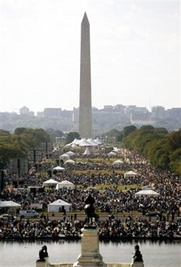
![]()
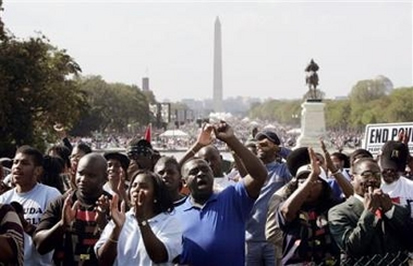
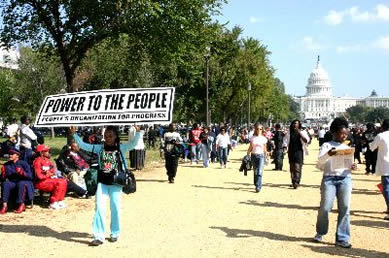
![]()

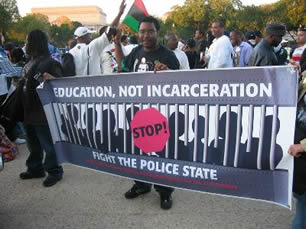
![]()

